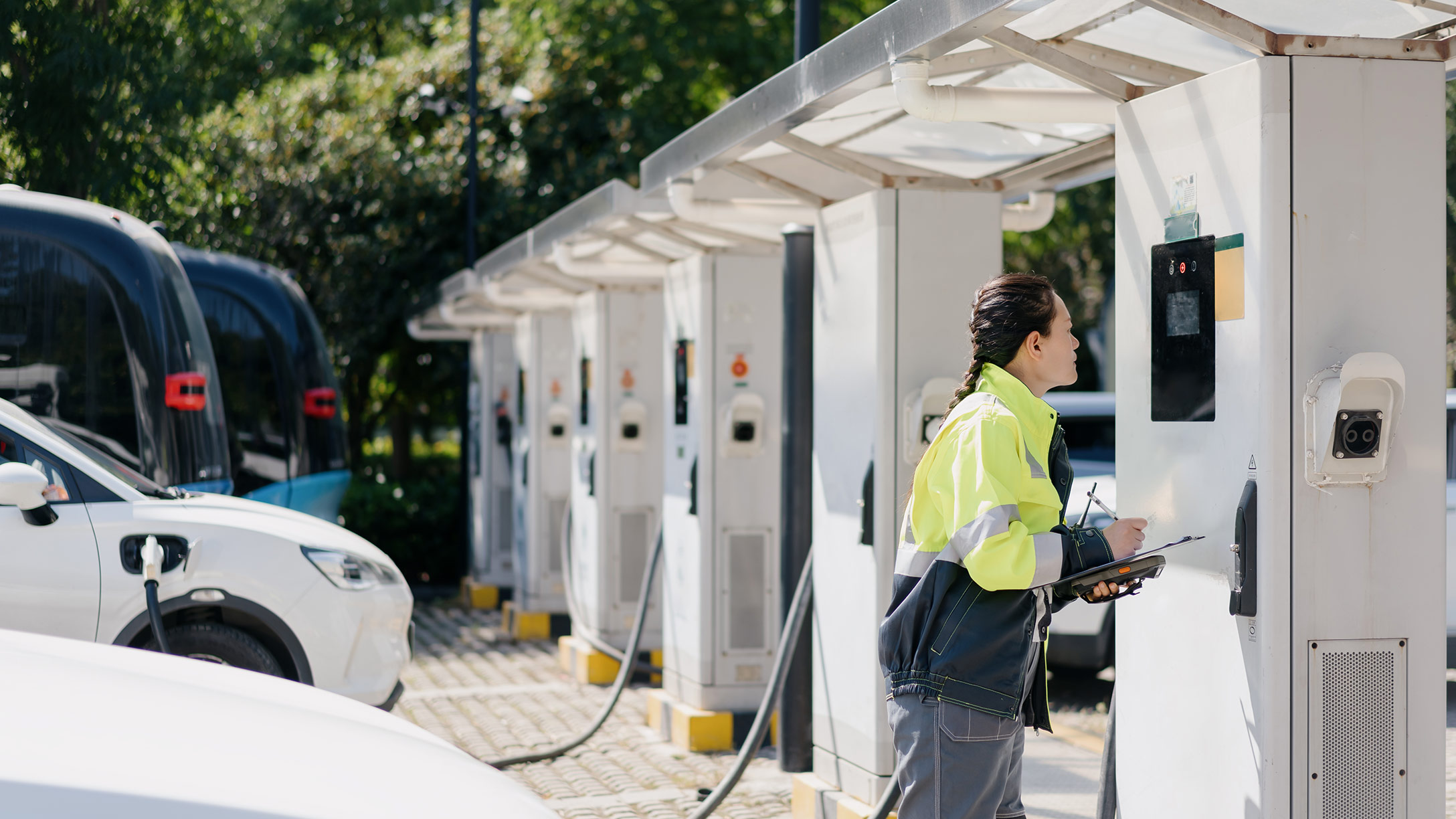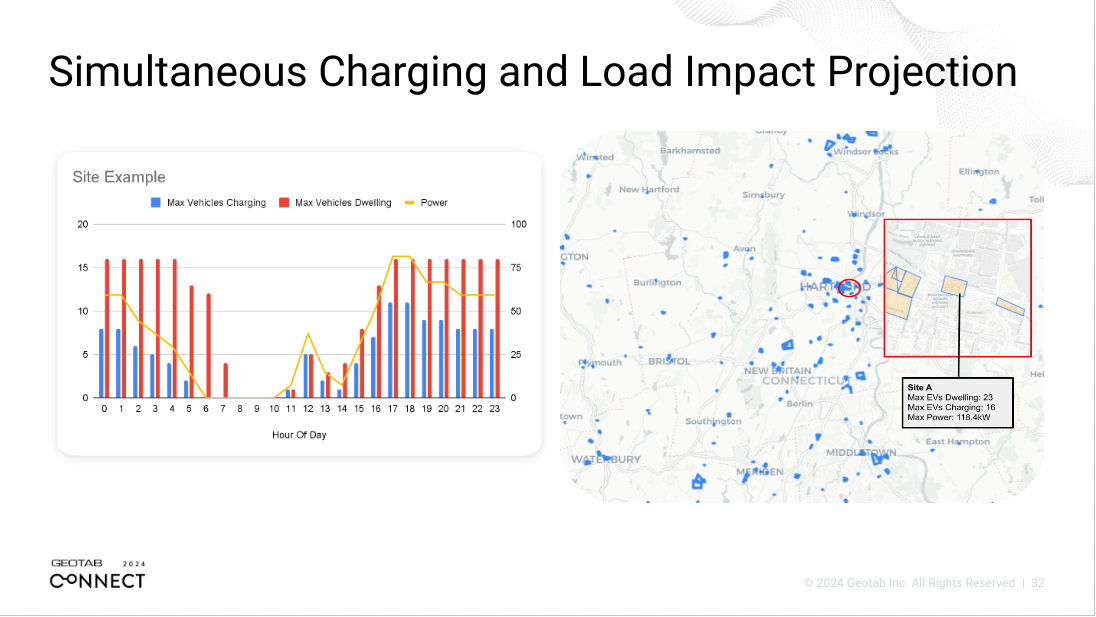Public sector fleet electrification: Insights from Geotab Connect
Key takeaways from the session “Fleet Electrification Planning for Government Agencies Going Electric.”

Jul 30, 2025

The panelists:
- Dave Munn - Branch Chief of Innovation, U.S. General Services Administration (GSA)’s Office of Fleet Management
- Ed Guelfi - Assistant Director of Fleet Operations, State of Connecticut’s Department of Administrative Services,
- Mark Goody - Senior Manager of Sustainability Solutions, Geotab
Together they brought unique perspectives on the challenges and opportunities for fleet electrification and powerful insights on electric vehicle (EV) infrastructure challenges. This discussion touched on key topics such as simplifying the fleet electrification process via data intelligence, critically assessing the steps involved and actual ways organizations are moving towards meeting EV deployment goals, including best practices for both EV acquisition and EV infrastructure planning.
Simplifying fleet electrification planning
Fleet electrification planning can be a complex process. Navigating the complexities of fleet electrification planning starts with collecting the right vehicle-side data: Measuring real-world duty-cycle data on driving profiles, seasonal EV range estimations across all EV model options, charging requirements, fuel usage and a calculated total cost of ownership (TCO) analysis all make it easier to pinpoint vehicle electrification opportunities and initiate them. Geotab helps enable fleets to leverage data intelligence to simplify the process.
Munn detailed how federal agency fleets can simplify EV acquisition planning via an Electric Vehicle Suitability Assessment (EVSA). As the leasing arm of the U.S. federal government fleet, GSA leverages Geotab’s EVSA solution to help assist federal agencies with surveying their fleet’s landscape for electrification feasibility, harvesting deep insights across the entire roster of vehicles to do so.
Compliance with President Joe Biden’s Executive Order (EO) 14057 is a key driver why GSA is helping agencies pinpoint EV acquisition opportunities, in addition to it making good business sense. EO 14057 requires 100% of light-duty vehicle acquisitions to be EV by 2027, and for all other vehicle types by 2035. As required in the EO 14057 implementing instructions, federal agencies “must deploy telematics and collect and use fleet operational data to inform fleet planning and zero-emission vehicle (ZEV) acquisition strategies, as well as ZEV and EVSE [electric vehicle supply equipment] operational management.”
In response to these requirements, GSA implemented a series of measures to develop a robust business and operational plan for fleet electrification, including increasing EV offerings and leveraging data intelligence via Geotab telematics software to ensure a data-driven approach.To help develop their fleet electrification plan, GSA, in collaboration with Geotab, deployed a customized model for their EVSA program that factors in specific GSA Feet metrics and real-world telematics data:
- Real-world range capabilities and applicable on-route charging requirements.
- A total cost of ownership (TCO) analysis including ZEV incremental costs.
- Strategies for reducing fleet CO2 emissions and fuel consumption by leveraging battery technology.
This EVSA solution helps GSA identify real-world range requirements, which ICE vehicles are the best candidates for EV replacement and applicable on-route charging thresholds, as they help support their agency clients in their respective fleet electrification journeys.
An example of a monthly range assurance chart that helps organizations move toward fleet electrification, factoring in key variables like weather and charging requirements:

Munn also mentioned how in January, GSA Fleet hosted their annual FedFleet conference in Washington, D.C. At this event, the Council of Environmental Quality’s Federal Chief Sustainability Officer was in attendance to evangelize the benefits of the EVSA solution for government agencies. GSA has already put this endorsement into practice by using Geotab’s EVSA solution to assess over 13,000 vehicles across 21 different bureaus.
Overcoming challenges by pivoting from EV acquisition to EV infrastructure
During the second portion of this discussion, Guelfi shared how the State of Connecticut partnered with Geotab in 2023 to conduct a fleet-wide EV Infrastructure Assessment (EVIA). Using Geotab, they discovered that their leased light-duty vehicles were traveling a total average 34 million miles a year by studying odometer reports.
Under Governor Ned Lamont’s Executive Order 1, an integrated sustainability strategy is mandated for government fleet operations. Senate Bill #4 Public Act #22-25, also known as the Connecticut Clean Air Act, establishes key fleet electrification targets:
- On and after January 1, 2026, at least 50% of such cars and light duty trucks must be Battery Electric Vehicles (BEVs).
- On and after January 1, 2028, at least 75% of such cars and light duty trucks must be BEVs.
- On and after January 1, 2030, 100% of such cars and light duty trucks must be BEVs.
If Connecticut’s vehicle leasing agency was to reach their 50 percent target by 2026, they would need to have 1,378 vehicles electrified, a number only feasible to reach if adequate EV infrastructure is deployed. Guelfi’s team focused on the EV infrastructure that would be needed to support this transition by partnering with Geotab. His agency was one of the first to deploy Geotab’s EVIA solution, a detailed report that helps determine charging needs including optimal locations for siting EV infrastructure, the number of charging heads recommended and incremental power needs (kW) for every site. The EVIA report detailed the following data insights and EV infrastructure requirements:
- Dwell times and charging locations: Determines which vehicles are most eligible for electrification based on when, where, and how long they dwell, compared to how much they drive.
- Charging heads required: Evaluates simultaneous vehicles charging to determine EV infrastructure requirements per site.
- Site load impacts: Calculates simultaneous charging energy load per site based on modeled charging cycles throughout the day.
The state of Connecticut also discovered site zoning inefficiencies they were able to adjust to accurately complete the EVIA. With realigned zones, detailed site and vehicle analyses and accurate load models, they were able to identify a large disparity between the number of charging stations they originally thought would be needed and what would actually be required. Guelfi presented these crucial EVIA findings to a sustainability and construction management group to help inform next steps relating to on-site engineering and construction for the deployment of EVSE at the optimal locations.
An example of a simultaneous charging and load impact projection analysis, demonstrating power availability and the maximum numbers of dwelling and charging vehicles in a given location.

Why fleet electrification matters for government organizations
There are three key arguments for the adoption of EVs. They include:
Government regulations - Federal governments are ratifying legislation to set transportation sustainability targets. They’re also providing funding to build up local grids with new public EV chargers, supporting organizations and constituents in their transition to cleaner transportation options. In the U.S., federal targets including the 50% EV sales share have been enacted, while some states have signed into law more stringent EV mandates to reduce their regions’ reliance on ICE vehicles. Internationally, other countries are similarly taking action by setting adoption deadlines for ZEVs. As more governments push their organizations to reduce their carbon footprint by switching to ZEVs, nations, provinces and states that are behind targets are encouraged to catch up to those currently leading the transportation decarbonization revolution.
Environmental considerations - A transition to ZEVs benefits the environment by reducing tailpipe emissions and lowering average vehicle lifetime emissions. Tailpipe emissions describe the carbon gases expunged by an internal combustion engine (ICE) vehicle while it’s in use, while total vehicle lifetime emissions refer to any emissions created either during the vehicle’s development or its regular fueling process. During fueling, even if electricity to charge the vehicle is being generated by burning a carbon-rich substance like coal, research indicates that an EV still results in fewer CO2 emissions than a gasoline-powered car will create. Government entities that add EVs to their fleets are leading by example, helping communities maintain cleaner breathable air and doing their part in reducing climate change impacts. In cities, provinces or states where there are higher numbers of environmentally-conscious constituents, taking initiative in phasing out ICE vehicles also helps to strengthen public trust. Governments that proactively take charge in establishing and meeting ZEV targets give residents more confidence in their leadership.
Financial considerations - Another factor to consider is the high price of maintaining and driving ICE vehicles. As EVs tend to have fewer moving parts than ICE vehicles, they usually require fewer repairs over time. This results in a lower TCO for an EV fleet, even despite a higher upfront acquisition cost. The lack of gasoline consumption offers additional savings throughout the lifetime of your EV fleet, as do tax credits, rebates and other incentives that may be available when purchasing electric vehicles.
The first step in moving your government fleet to EVs
When creating a plan to transition your fleet vehicles to electric vehicles, the first and most crucial step is choosing the right telematics partner. In addition to being a proven leader in sustainable telematics technologies, your telematics partner should have the tools to not only inform and simplify your electrification journey but also to monitor your EVs in the same platform as your ICE vehicles.
“As more vehicles become connected, and more reliable information is gathered, this type of study [EVSA] can only get better. We’re not in the business of guessing how things will impact our fleet. We want to use real-world data to help our customers any way we can.” — Dain Giesie, Assistant Vice President, Enterprise Fleet Management
Whether through large scale studies, Connect’s public sector fleet electrification session or our extensive work with public sector and commercial customers, Geotab is dedicated to being at the forefront of the sustainability revolution by helping local, state and federal agencies undergo scalable, cost-effective EV transformations.
Don’t undergo an EV transition in the dark without partnering with a leader in sustainable technologies to light the path for you. Book a demo today.
We hope you enjoyed these insights and we’ve provided a curated list of assets below to illuminate the road to your fleet electrification goals.
We hope you enjoyed these insights and we’ve provided a curated list of assets below to illuminate the road to your fleet electrification goals.
- Selection guide: Explore our end-to-end guide for choosing a telematics platform that’s built to help you procure EVs and effectively measure the results of an EV transition. Read the article
- Checklist PDF: is your telematics provider able to fully support your electrification journey? Download the checklist of features required to support the adoption and management of EVs in your fleet. EV RFP checklist PDF
- Sustainable Fleet Solutions webpage: Discover more about how Geotab can enable you to save money, reduce emissions and electrify your vehicles with sustainable telematics. Visit the webpage
Subscribe to get industry tips and insights

Content Marketing Manager at Geotab
Table of Contents
Subscribe to get industry tips and insights
Related posts

Run on Less data redefines electric truck viability
December 17, 2025
4 minute read

Law enforcement technology: Four trends to know for 2026
November 7, 2025
6 minute read

Four seasons of fleet intelligence with Geotab's Public Works solution
November 7, 2025
2 minute read

Slash fleet costs: Key strategies for a stronger police budget
October 14, 2025
5 minute read

School bus safety week: The top solutions for safer student journeys
October 7, 2025
4 minute read
